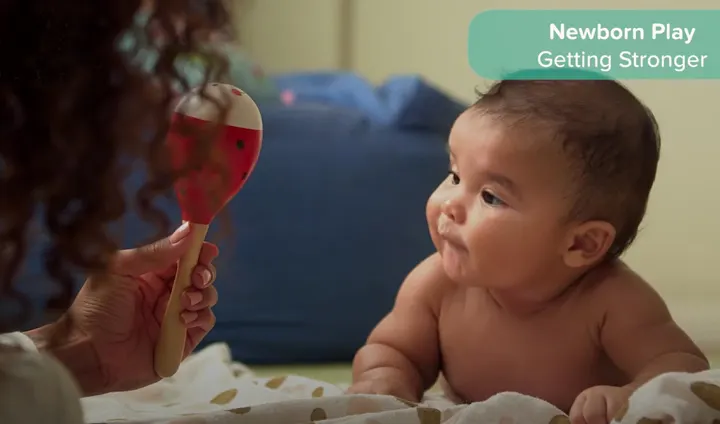When Do Babies Hold Up Their Heads Unsupported?
As your baby grows from a seemingly fragile newborn to an independent toddler, you’ll marvel at all the physical changes along the way. One of these is head control. You may be wondering when “should” a baby hold their head up on their own without your support. This will be a wonderful development milestone to see, but when is it likely to happen? Find out more about your baby’s head control and why supporting your baby’s head is so important in the meantime.
When Can Babies Hold Their Own Head Up?
So, when does a baby hold their head up? When your little one reaches about 4 months old, you’ll most likely see them hold their head and chest up as they lean on their elbows while lying on their tummy.
This is a big moment! Your baby has reached a major milestone, because now they have the freedom to look any which way they please.
Keep in mind that every baby is different and develops at a different rate. Your baby may reach this milestone a little earlier or later than this. Still, if you’re wondering is it normal for a newborn or a 2-week-old to hold their head up, know that developmentally a baby that young wouldn’t be able to hold their head up.
How Your Baby Develops the Strength to Hold Their Head Up
When your baby is between 1 and 3 months old, they’ll gradually gain the strength needed to hold their head up.
You may be wondering how much head control a 2-month-old “should” have. By around 2 months, while you’re baby is lying on their stomach, you might notice they can raise their head for just a few seconds at a time.
These brief moments help strengthen the muscles in the back of their neck. Eventually they will also start to develop control of their front neck muscles for total head and neck control.
Other Developments Around the Time Your Baby Starts to Hold Their Head Up
You can also look forward to the following forms of physical development around the time your baby is able to hold their head up:
Your baby’s abdominal muscles will be getting stronger, which means your baby will be able to raise their head and chest when lying on their back
Your baby’s legs will become stronger as they kicks will go from being reflexive to forceful, and their legs will begin to lose the bowing they had when they were a newborn
Your baby will be able to roll over, which also means it’s worth keeping a close eye and a hand on your little one when they’re up above floor level, such as when they’re on the changing table.
How Can You Help Your Baby Develop Their Head Control?
To help your baby strengthen the neck and back muscles needed to hold their head up independently, give your baby tummy time every day. An ideal time to start tummy time is soon after you bring your baby home from the hospital.
Tummy time involves laying your baby on their stomach two to three times a day for short periods, such as three to five minutes, with your close supervision.
Daily tummy time sessions can help your baby strengthen their neck, back, and shoulder muscles as they crane to look up at you. And, you can even dangle toys in front of them to encourage them to look up and engage those muscles.
How You Might Support Your Baby’s Head in the Meantime
In your baby’s first few months, you’ll need to carry them carefully to ensure their head doesn’t flop from side to side or front to back.
Cradle your baby’s head when carrying them in the lying position and support their head and neck when carrying them upright.
Eventually they’ll be able to hold their head up, and you will no longer need to provide this type of support.
When Can You Stop Supporting a Baby’s Head?
By the time your baby is about 4 months old, they will likely be able to hold up their head and chest as they support themselves on their elbows, giving them more freedom and control to look around. This will be a nice change for you, as you won’t have to support your baby’s head as much as you did before when carrying them.
Even so, it’s important to watch out for sudden or forceful movements when carrying your baby. Carry them carefully and steadily when moving from place to place.
What if Your Baby Isn’t Able to Hold Their Head Up Yet?
It’s natural for some babies to develop a little earlier or later than others, as each baby is unique. However, if you think your baby isn’t mastering head and neck control and they’re already around 4 months old, check in with their healthcare provider.
Try not to worry unnecessarily, though. Instead, consult your baby’s healthcare provider, who will be able to track your little one’s development, notice any issues, and recommend the right treatment options where necessary.
The Bottom Line
Watching your baby reach each development milestone will fill you with pride and joy. Improved head and neck control is just one of the things you can to look forward to. In no time at all, your baby will be crawling, walking, talking and so much more!
Not all parts of parenting are as exciting as seeing another milestone reached. Diaper duty awaits! To make these everyday moments feel almost as rewarding as those precious baby development milestones, download the Pampers Club app—you’ll earn Pampers Cash on all your diaper purchases.
The information in this article is based on the expert advice found in trusted medical and government sources, such as the American Academy of Pediatrics and the American College of Obstetricians and Gynecologists. You can find a full list of sources used for this article below. The content on this page should not replace professional medical advice. Always consult medical professionals for full diagnosis and treatment.
Join Pampers Club and get:






